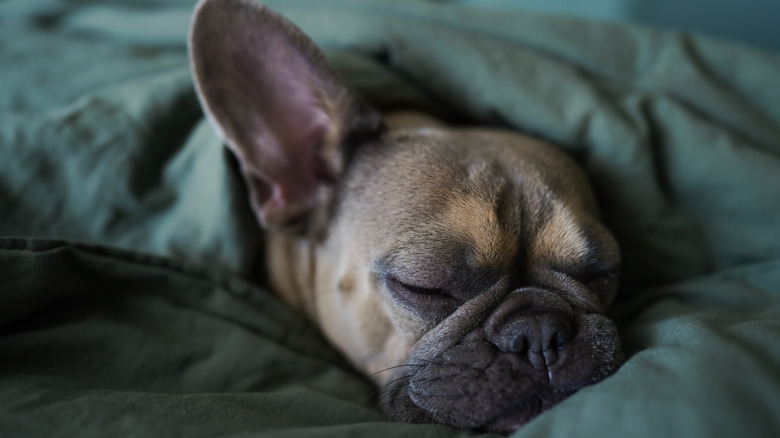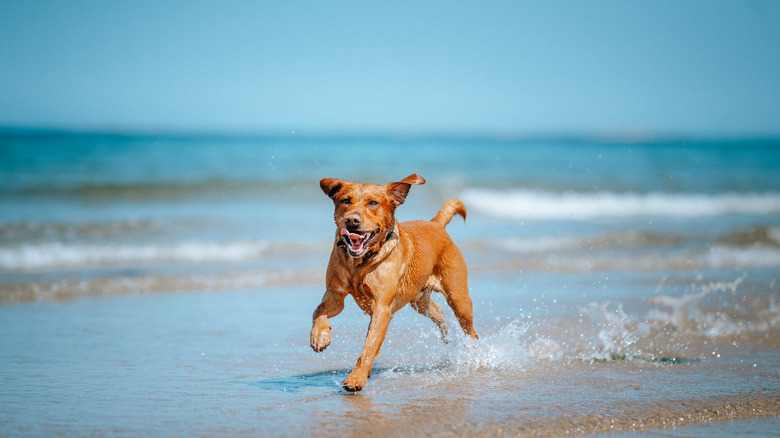How To Tell If Your Dog Is Having A Bad Dream (& What To Do About It)
You may have observed your pup running, yipping, or twitching in their sleep, leading you to wonder: Can dogs have nightmares? Researchers and professionals believe that canines and humans dream in similar ways, based on how their brain activity looks when they're asleep. As veterinary health expert Gary Richter, DVM, explained to Reader's Digest, "Because of these similar brain wave patterns, dogs actually do experience multiple sleep stages during a standard sleep cycle, including dreams that cause rapid eye movement or REM sleep, which is where we see them twitching while sleeping."
Moreover, research published by MIT in 2001 hypothesized that many animals, including dogs, are capable of having "complex dreams" and keep track of "long sequences of events" in their sleep. As for how often dreams happen, well, that's sort of a pup-by-pup situation. In general, puppies dream more than adult dogs since they're processing so much more new information during the day, and small dogs dream more than big dogs. But there's always variation.
The good news is that, similar to humans, most dog dreams are not nightmares, so even if your pup appears to be whimpering in their sleep, there's a strong chance they're fine. However, if they're behaving in an unusual manner, such as barking or growling, it's possible they're not experiencing a sweet dream.
What do dogs dream about?
Because of the similarities in brain activity, some vets have concluded that, like humans, dogs probably dream about their real lives and experiences, including the people they encounter regularly. (That's you!) Veterinary behaviorist and service chief at the University of California-Davis School of Veterinary Medicine Dr. Liz Stelow told Forbes Advisor that research into how dogs shift their bodies physically during sleep supports this hypothesis. "Paw movements and lip movements suggest that dogs may be reliving things they have experienced. So, running, playing, fighting, [and] eating." In other words, your pup pretending to run in their sleep doesn't necessarily mean they're having a nightmare about being chased. Rather, they may be thinking about the squirrel they saw at the park.
Still, this doesn't mean that every dream is a good one. Occasionally, a dog may cry in their sleep, which can indicate that they're in the midst of a nightmare. Other signs of a potential bad dream include barking or growling. And, although uncommon, dogs are also capable of experiencing night terrors, a rapid feeling of anxiety that happens during the early stages of sleep. These episodes can come on suddenly and last as long as 40 minutes. Some tell-tale signs your pup is experiencing a night terror are sudden, uncontrolled body movements, loud barking, heavy breathing, or twitching.
What to do if your dog has a bad dream
If you notice your dog twitching in their sleep or their eyes moving behind their lids, that means they've entered REM and are dreaming! It can be tempting to try to wake them out of this state, especially if they seem distressed or frightened. However, the best thing you can do for a dog who is experiencing a vivid or potentially bad dream is leave them alone to sleep in a protected, comfortable place.
It's much safer — for children and adults alike — to let a dreaming pup be and not try to comfort them. Some dogs may wake up from a bad dream in an aggressive state, and it can take them a minute to orient themselves. According to VCA Animal Hospitals, about 60% of dog bites in children happen because they chose to wake a sleeping canine. If this behavior occurs on a regular basis, your pup could be contending with a sleep disorder, and a trip to the vet is in order. But, if it's just a one-time thing, remember to keep your hand to yourself and trust that your pup will get themselves out of their dreams, even the bad ones. They may just need some extra cuddles when they wake up.


